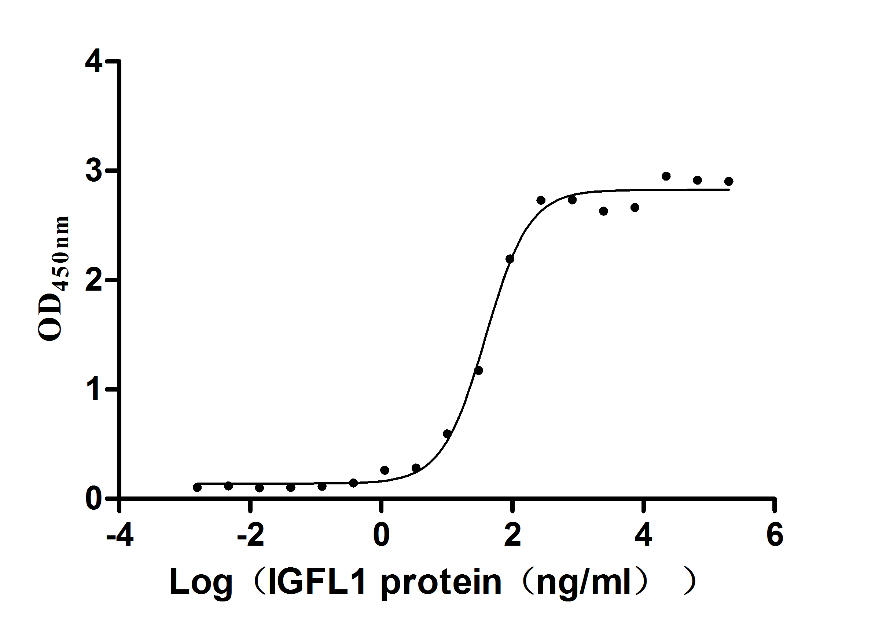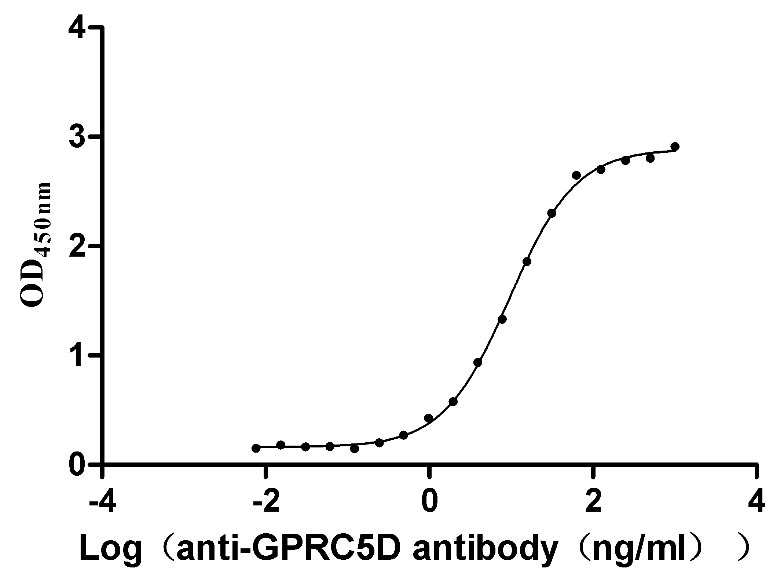Recombinant Mouse Neuronal PAS domain-containing protein 4 (Npas4), partial
-
中文名稱:小鼠Npas4重組蛋白
-
貨號:CSB-YP806820MO
-
規(guī)格:
-
來源:Yeast
-
其他:
-
中文名稱:小鼠Npas4重組蛋白
-
貨號:CSB-EP806820MO
-
規(guī)格:
-
來源:E.coli
-
其他:
-
中文名稱:小鼠Npas4重組蛋白
-
貨號:CSB-EP806820MO-B
-
規(guī)格:
-
來源:E.coli
-
共軛:Avi-tag Biotinylated
E. coli biotin ligase (BirA) is highly specific in covalently attaching biotin to the 15 amino acid AviTag peptide. This recombinant protein was biotinylated in vivo by AviTag-BirA technology, which method is BriA catalyzes amide linkage between the biotin and the specific lysine of the AviTag.
-
其他:
-
中文名稱:小鼠Npas4重組蛋白
-
貨號:CSB-BP806820MO
-
規(guī)格:
-
來源:Baculovirus
-
其他:
-
中文名稱:小鼠Npas4重組蛋白
-
貨號:CSB-MP806820MO
-
規(guī)格:
-
來源:Mammalian cell
-
其他:
產(chǎn)品詳情
-
純度:>85% (SDS-PAGE)
-
基因名:Npas4
-
Uniprot No.:
-
別名:Npas4; Nxf; Neuronal PAS domain-containing protein 4; Neuronal PAS4; HLH-PAS transcription factor NXF; Limbic-enhanced PAS protein; LE-PAS
-
種屬:Mus musculus (Mouse)
-
蛋白長度:Partial
-
蛋白標簽:Tag?type?will?be?determined?during?the?manufacturing?process.
The tag type will be determined during production process. If you have specified tag type, please tell us and we will develop the specified tag preferentially. -
產(chǎn)品提供形式:Lyophilized powder
Note: We will preferentially ship the format that we have in stock, however, if you have any special requirement for the format, please remark your requirement when placing the order, we will prepare according to your demand. -
復(fù)溶:We recommend that this vial be briefly centrifuged prior to opening to bring the contents to the bottom. Please reconstitute protein in deionized sterile water to a concentration of 0.1-1.0 mg/mL.We recommend to add 5-50% of glycerol (final concentration) and aliquot for long-term storage at -20℃/-80℃. Our default final concentration of glycerol is 50%. Customers could use it as reference.
-
儲存條件:Store at -20°C/-80°C upon receipt, aliquoting is necessary for mutiple use. Avoid repeated freeze-thaw cycles.
-
保質(zhì)期:The shelf life is related to many factors, storage state, buffer ingredients, storage temperature and the stability of the protein itself.
Generally, the shelf life of liquid form is 6 months at -20°C/-80°C. The shelf life of lyophilized form is 12 months at -20°C/-80°C. -
貨期:Delivery time may differ from different purchasing way or location, please kindly consult your local distributors for specific delivery time.Note: All of our proteins are default shipped with normal blue ice packs, if you request to ship with dry ice, please communicate with us in advance and extra fees will be charged.
-
注意事項:Repeated freezing and thawing is not recommended. Store working aliquots at 4°C for up to one week.
-
Datasheet :Please contact us to get it.
靶點詳情
-
功能:Transcription factor expressed in neurons of the brain that regulates the excitatory-inhibitory balance within neural circuits and is required for contextual memory in the hyppocampus. Plays a key role in the structural and functional plasticity of neurons. Acts as an early-response transcription factor in both excitatory and inhibitory neurons, where it induces distinct but overlapping sets of late-response genes in these two types of neurons, allowing the synapses that form on inhibitory and excitatory neurons to be modified by neuronal activity in a manner specific to their function within a circuit, thereby facilitating appropriate circuit responses to sensory experience. In excitatory neurons, activates transcription of BDNF, which in turn controls the number of GABA-releasing synapses that form on excitatory neurons, thereby promoting an increased number of inhibitory synapses on excitatory neurons. In inhibitory neurons, regulates a distinct set of target genes that serve to increase excitatory input onto somatostatin neurons, probably resulting in enhanced feedback inhibition within cortical circuits. The excitatory and inhibitory balance in neurons affects a number of processes, such as short-term and long-term memory, acquisition of experience, fear memory, response to stress and social behavior. Acts as a regulator of dendritic spine development in olfactory bulb granule cells in a sensory-experience-dependent manner by regulating expression of MDM2. Efficient DNA binding requires dimerization with another bHLH protein, such as ARNT, ARNT2 or BMAL1. Can activate the CME (CNS midline enhancer) element.
-
基因功能參考文獻:
- Results suggest that Npas4 mediates susceptibility to adolescent stress and subsequent cognitive functioning and inhibitory tone in adulthood. This shows a novel gene by environment interaction related to resilience vs vulnerability to stress, with implications for adolescent onset disorders like schizophrenia. PMID: 29345055
- ectopic expression of miR-744 and miR-224 during neural differentiation resulted in downregulation of endogenous Npas4 expression. PMID: 27189618
- Using a series of behavioral, molecular, pharmacological and genetic approaches in mice, study shows that deficiency in Npas4 affects adolescent expression of multiple markers of GABAergic transmission in the PFC, including parvalbumin and GAD67, in a sex-specific manner. Abnormal pattern of expression of GABAergic markers is associated with sex-specific and age-dependent cognitive and emotional impairments. PMID: 27993645
- The findings of this study suggest that Npas4 may be involved in post-stroke psychiatric changes related to anxiety ad sociability. PMID: 27574128
- NPAS4 is expressed in endothelial cells, regulates VE-cadherin expression and regulates sprouting angiogenesis. PMID: 28082451
- These findings suggest that 11beta-HSD1 may contribute to the decline in Npas4 and Arc mRNA levels associated with memory impairment during ageing PMID: 26563879
- beta cell cytotoxicity of the calcineurin inhibitor and immunosuppressant tacrolimus (FK-506) was prevented by Npas4 overexpression. PMID: 26663079
- Results suggest that transcription of the Npas4 gene is downregulated by stress through DNA methylation of its promoter PMID: 26222956
- induction of Npas4 identifies the area influenced by cortical spreading depression propagation. PMID: 25912092
- Cortex activation by sensory conditioning was found to upregulate the expression of both Npas4 and c-Fos. PMID: 25785202
- Data showed that differential levels of Npas4 expression in the brain may regulate anxiety, depression and cognition related disorders. PMID: 25549857
- Npas4 regulates Mdm2 expression during dendritic spine development in newborn olfactory bulb after sensory experience. PMID: 25088421
- we provide the first evidence that Npas4 is expressed during embryonic development and that it may have a developmental role that is unrelated to its function in the adult brain PMID: 24887558
- Study describes a transcriptional program that is induced by neuronal activity in inhibitory neurons; while neuronal activity induces expression of early-response transcription factors such as Npas4 in both excitatory and inhibitory neurons, Npas4 activates distinct programs of late-response genes in inhibitory and excitatory neurons. PMID: 24855953
- Our results reveal REST and microRNA dependent mechanisms that restrict NPAS4 expression to the brain PMID: 24291638
- sensory stimuli, by inducing NPAS4 and its target genes, differentially control spatial features of neuronal inhibition in a way that restricts the output of the neuron while creating a dendritic environment that is permissive for plasticity PMID: 24201284
- Npas4 is a key activity-dependent regulator that improves beta-cell efficiency in the face of stress. PMID: 23656887
- This study demonistrated that Npas4 is involved in activity-dependent changes to input connectivity to adult-born DG GCs but not to their output connectivity in CA3. PMID: 23637184
- Optical activation of striatal medium spiny neurons induced immediate early gene expression evidenced by increased Npas4 proetin. PMID: 23300775
- NPAS4 plays an important role in the structural and functional plasticity of neurons PMID: 23172225
- Npas4 may play a major role in the regulation of cognitive and social functions in the brain with possible implications for developmental disorders such as schizophrenia and autism. PMID: 23029555
- These results suggest that transcription of Npas4 is down-regulated by stress via the binding of agonist-bound glucocorticoid receptor to its promoter. PMID: 23020797
- by recruiting RNA polymerase II to promoters and enhancers of target genes, Npas4 regulates a learning-specific transcriptional program in CA3, which suggests Npas4 is a master regulator of activity-regulated gene programs and central to memory formation PMID: 22194569
- Corticosterone-induced down-regulation of Npas4 expression may play a role in stress-induced impairment of hippocampal function. PMID: 20626564
- identification of transcription factor Npas4, that plays a role in the development of inhibitory synapses by regulating the expression of activity-dependent genes, which in turn control the number of GABA-releasing synapses that form on excitatory neurons PMID: 18815592
- NXF gene could be induced in response to several neurodegenerative stimuli/excitations for the cell protection, and thus provide an "on demand" cell-protection system in nervous tissue PMID: 19001414
顯示更多
收起更多
-
亞細胞定位:Nucleus.
-
組織特異性:Mainly expressed in brain. Expressed in the limbic system and olfactory bulb. Specifically expressed in CA1 and CA3 region of the hippocampus after contextual learning (at protein level). Also expressed in pancreatic beta cells.
-
數(shù)據(jù)庫鏈接:
Most popular with customers
-
Recombinant Human Semaphorin-4D (SEMA4D), partial (Active)
Express system: Mammalian cell
Species: Homo sapiens (Human)
-
Recombinant Human IGF-like family receptor 1 (IGFLR1), partial (Active)
Express system: Mammalian cell
Species: Homo sapiens (Human)
-
Recombinant Mouse Prolactin receptor (Prlr), partial (Active)
Express system: Mammalian cell
Species: Mus musculus (Mouse)
-
Recombinant Human G-protein coupled receptor family C group 5 member D (GPRC5D)-VLPs (Active)
Express system: Mammalian cell
Species: Homo sapiens (Human)
-
Recombinant Human Claudin-6 (CLDN6)-VLPs (Active)
Express system: Mammalian cell
Species: Homo sapiens (Human)
-
Recombinant Human Interleukin-17A (IL17A) (T26A) (Active)
Express system: Baculovirus
Species: Homo sapiens (Human)
-
Recombinant Human Cadherin-17 (CDH17), partial (Active)
Express system: Mammalian cell
Species: Homo sapiens (Human)
-
Recombinant Rat Gastric inhibitory polypeptide receptor (Gipr), partial (Active)
Express system: Mammalian cell
Species: Rattus norvegicus (Rat)






-AC1.jpg)
-AC1.jpg)










